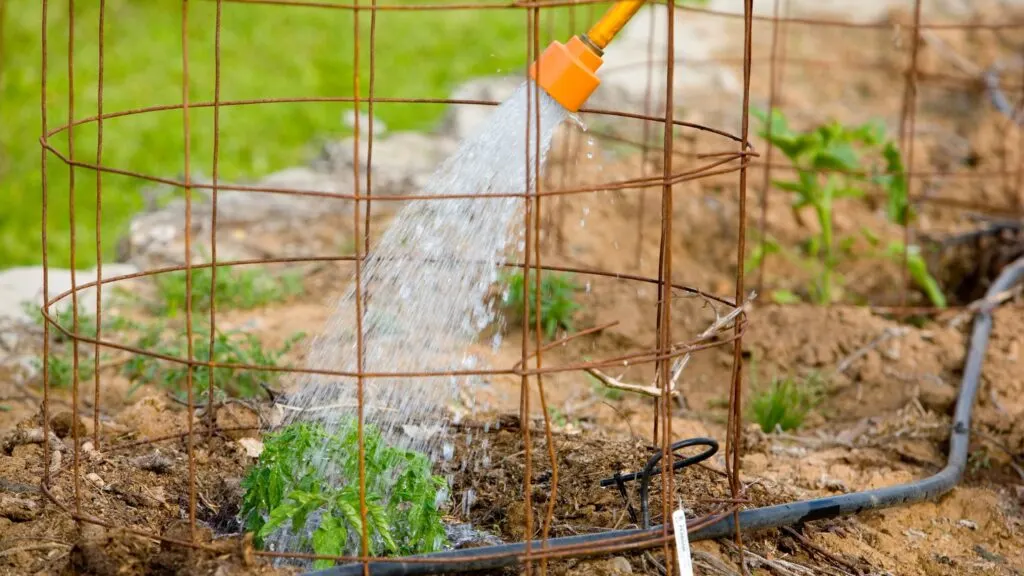Tomato Stakes are one of those things I hate to pay for because they aren’t cheap at your local garden store. Yet when you want to plant enough tomato plants to can sauce, salsa, and more, you find yourself scrambling to keep the tomatoes supported.
And let’s not forget the big debate- is a tomato a fruit or a vegetable?
Tomato staking is an essential aspect of gardening for homesteaders. It not only helps maintain healthy plants but also maximizes the yield of your tomato crop. We all know how horrible the tomato cages are from the store, and they usually last one, MAYBE two years if you are lucky.

This year I decided I didn’t want to deal with the annoying cages and see if I could use what we already had.
In this blog post, we’ll explore the importance of tomato staking, its benefits, and six practical, frugal ways to stake tomatoes in your garden.

The Importance of Tomato Staking
Staking tomatoes provides several benefits, including:
- Improved Air Circulation: Staked plants have better air circulation, minimizing the chance of mold and mildew development.
- Easier access to sunlight for photosynthesis
- Prevention of fruit from touching the ground, minimizing rot and pest damage
- Easy Harvesting: Staked tomatoes are more accessible, making it easier to monitor their ripening and harvest the fruits.
- Increased Yield: Staked tomatoes receive better sunlight exposure, leading to increased photosynthesis and higher fruit production.
- Space Optimization: Staked plants take up less space, allowing you to grow more tomatoes in limited areas.
- Aesthetic Appeal: Staked tomatoes create an organized and tidy garden appearance.
There are various staking methods, such as cages, single stakes, and trellises. However, store-bought options can be expensive.
Let’s explore six cost-effective and inventive ways to stake your tomatoes.

1. Repurposed Wooden Stakes
Materials: Old wooden planks, branches, or scrap wood
Instructions: Cut the wood into stakes that are approximately 5-6 feet long and 1-2 inches wide. Drive the stakes about 1 foot into the ground next to each tomato plant. Secure the plants to the stakes using garden twine or cloth strips as they grow.
Check out this DIY wooden step by step plan.

2. Bamboo Poles
Materials: Bamboo poles
Instructions: Insert a bamboo pole next to each tomato plant, pushing it about 1 foot into the ground. As the plants grow, tie them to the poles using soft ties or garden twine, leaving some slack for growth.
Check out this video on how to make yours!

3. String Trellis
Materials: Wooden stakes, garden twine or durable string
Instructions: Place wooden stakes at both ends of the tomato row, driving them 1 foot into the ground. Tie the garden twine between the stakes at 6-8 inches intervals, creating a horizontal trellis. As the tomato plants grow, weave them through the strings for support.
Check out these videos for inspiration and how tos.

4. Upcycled Wire Fencing
Materials: Wire fencing or chicken wire, wooden stakes or metal T-posts
Instructions: Cut a piece of wire fencing to fit the length of your tomato row. Attach the fencing to wooden stakes or metal T-posts at intervals along the row. Guide the plants through the openings in the fencing as they grow.
Check out this post for a cheap way to do it.
5. PVC Pipe Cage
Materials: PVC pipes, PVC pipe connectors, garden twine
Instructions: Construct a square or rectangular cage using PVC pipes and connectors. The cage should be about 2 feet wide and 4-5 feet tall. Place the cage over a tomato plant, pushing the bottom pipes into the ground for stability. Tie the tomato plant to the PVC pipes as it grows.
The image above is from the Blog Raise Your Garden, and they have a great article on how to make your PVC pipe cages here.
Check out this video on how to make your PVC pipe cage.
6. Old Ladders
Materials: Old wooden or metal ladders
Instructions: Position the ladder(s) next to your tomato plants, leaning them against a sturdy fence or wall. Secure the tomato plants to the ladder rungs using garden twine or cloth strips as they grow.
Check out this blog post for examples.
Key Takeaways and Call-to-Action
Staking tomatoes is crucial for healthy plants and a bountiful harvest. By using creative and frugal techniques, you can support your tomato plants without breaking the bank.
We encourage you to try these methods and share your experiences in the comments below. If you have any favorite tomato staking techniques, we’d love to hear about them! Happy gardening!

